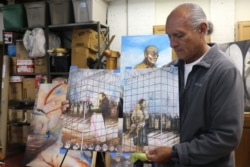Mexican-American artist Ricardo Santos Hernandez fondly recalls his boyhood in Nogales, Arizona, a border city where young Latinos like himself grew up able to cross to and from Mexico and enjoy the best of both worlds.
“My experience growing up in Nogales was a beautiful one, where we had the privilege to go back and forth [to Mexico],” he said. “Back then, border policies and immigration were lenient as opposed to what is happening now.”
So he said he was “startled and frazzled” by some of the anti-immigrant rhetoric that accompanied the launch of Donald Trump’s presidential campaign in 2015, including a now infamous remark that Mexicans entering the United States were “bringing drugs. They’re bringing crime. They’re rapists. And some, I assume, are good people.”
But rather than just feel angry, Hernandez decided to use his skills as an artist to try to provide a counternarrative. “I started an art project with the artists from the border in response to the negative rhetoric that was highlighted every day on the mainstream media,” he recalled while sitting in his basement studio in the Edgewater neighborhood of Chicago.
Hernandez began by reaching out to a friend and fellow Arizona artist. Together, they formed the Ambos Nogales Border Art Project, made up of artists who grew up on both sides of the U.S.-Mexican border. Their goal, he said, was “to reverse the demonization of immigrants crossing the border” by using art as a tool to create understanding.
Some of Hernandez’s more controversial works take direct aim at Trump administration policies, including the separation of families and the detention of children in wire mesh “cages.” Those policies have been widely denounced by human rights groups and immigrant supporters as cruel and unnecessary.
But U.S. Representative Clay Higgins, a Louisiana Republican who serves on a House subcommittee that deals with border security, argues that U.S. Customs and Border Protection staff have been unfairly criticized.
Forced to rethink mission
“CBP agents and officers, already short-staffed, had to refocus their mission from stopping gangs, drugs, murderers, rapists, and even known or suspected terrorists to instead process and care for the hundreds of thousands of people that arrived at our border, without the appropriate facilities, resources and medical support staff to do so,” he said during a recent subcommittee hearing.
“Yet CBP law enforcement officers still scraped together money out of their own pockets to buy toys and bring in extra supplies for the migrants in their custody, many of them parents themselves.”
The issue hits close to home for Hernandez, who is a third-generation Mexican American. He has been living and working in Chicago since 1996, but he still makes frequent trips to Nogales and has family on the Mexican side as well.
He said the cross-border visits are much more difficult now, because travelers face long lines, hours of waiting, more questioning and several stages of inspections when trying to return to Arizona.
Hernandez has repeatedly encountered migrants attempting unauthorized entry into the United States during his visits to the Mexican side of Nogales, and even assisted them by providing advice, water, food and shelter in his family home.
“These people are walking in the desert in harsh conditions, and if it’s the summer, we’re talking about 105 to 110 degrees [F],” he said. “In the winter months, the dry, bitter cold of the desert is piercing.”
Hernandez uses his artwork, which consists of oil paintings, drawings, murals and etchings, to try to make Americans more sympathetic toward the would-be migrants. He said he believes his artwork can deliver his message more effectively than words.
“I think the visual arts don't put the words in your mouth,” he said. “It gives you the opportunity to see, absorb what’s happening, and then you come up with your own criteria, with your own ability to inform yourself.”
One of Hernandez’s pieces, titled “Caged,” was created by using several different media such as gouache (opaque watercolor), acrylic paint and a collage of photos. It shows a migrant mother holding her baby while in a cage with people waving American flags in the background.
The painting functions as a study for a mural that Hernandez is planning to paint in either the artsy neighborhood of Pilsen or Back of the Yards, another Chicago neighborhood with a large Mexican community. He said immigration would be just one of several political themes in the final mural.
Current work
Hernandez is still searching for a building to paint the mural on and awaiting approval from community officials, but he hopes to start the project this year.
Currently, he is working on a piece titled “I Am the Santa Cruz River,” an oil painting approximately 7 feet tall. This project touches on the significance of the Santa Cruz River in Arizona, which is shared by the U.S. and Mexico.
Hernandez notes that the river flows from south to north, just like the migrants who follow its course while seeking a surreptitious entry into the United States. The painting will also depict a high wall being built along the border, which has become a symbol of Trump’s effort to halt illegal immigration from Mexico.


